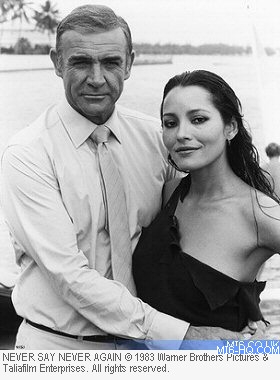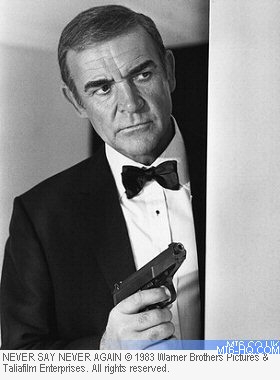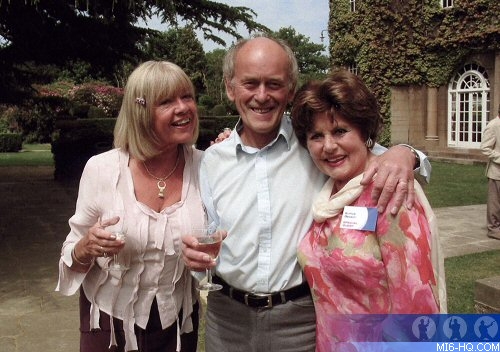 |
| |
MI6 caught up with Academy Award winner Norman Wanstall
to talk about how working on Never Say Never Again
compared to the official film series...
|
|
Norman Wanstall Interview (2)
20th February 2008
You've worked on the official Bond series but also on McClory's "Never
Say Never Again" - can you describe the differences,
if any,
in the filmmaking approach to these two rival Bond companies?
I accepted the invitation to return to the film industry for Never
Say Never Again because I thought it would be a new adventure for
me and also my experience of Thunderball would be useful to the
production. As it turned out it was a disastrous decision and a
very unhappy experience, and from what I remember it was a pretty
unhappy experience for a lot of people.
Apart from the fact that
instead of the close-knit crew I’d worked with in
the past I was working with people who’d never been
on a Bond film before, we had two guys arrive from the
States who appeared to have a lot of power and from then
on the film seemed to be in the hands of a committee. One
of the guys who was there to keep his eyes on finances
turned out to be a very nasty piece of work indeed, and
caused a lot of bad feeling amongst the crew.
A huge problem for me was
the fact that the production manager (who was always the
one I turned to for arranging my outside recording requirements)
was pushed off the picture soon after shooting, so I was
left to cope alone and spend hours on the phone doing work
that would never normally be my responsibility. Also I’d
always been used to working at Pinewood Studios where the
chief sound mixer Gordon McCullum and I had built up a
good rapport. He loved working on the Bonds and would always
find time for me in his theatre to create difficult sounds
at a very early stage, which made life easier for all concerned
when dubbing began in earnest. |
|
 Above:
Sean Connery and Barbara Carrera in Never Say Never Again
(1983) Above:
Sean Connery and Barbara Carrera in Never Say Never Again
(1983) |
Unfortunately Never Say Never Again was made at EMI Elstree,
where the chief mixer Bill Rowe was never available for me to
use his theatre and he’d never even seen a Bond film. As
a result we never developed a good working relationship and I
got no pleasure from the job at all.
The biggest problem by far though was the fact
that the script hadn’t been thoroughly scrutinised before
shooting began, which was unforgivable. The most important rule
in film-making
is that the script must be water-tight before shooting begins,
otherwise serious problems will arise later if there are gaps
in the story-line. In the final version of Never Say Never it
was never explained why Bond decided to go the Bahamas, and it
was never explained how the marines knew where to find Bond when
he was trapped in the cave at the end. There were other areas
in the film where I cringed as lines of dialogue were laid off
screen or on the back of heads in an attempt to explain the lot
plot.

|
|
Finally, when we eventually reached the
dubbing session when all the sound-tracks were mixed together,
we
had a committee in the recording theatre which was a complete
nightmare. Everyone had an opinion on everything, and endless
discussions would arise at every stage. The music did nothing
to enhance the picture and by the end of the production
I was totally disillusioned and couldn’t wait to get
back to my country retreat.
The only positive aspect of the
film was the fact that technology had moved on since the
days of Thunderball and I was put in touch with a man who
could create sounds to order. He had the machines and the
expertise and was invaluable when it came to creating sounds
for scenes such as the electronic table game played out
between Bond and the villain. We projected the scenes in
his studio
and once I’d explained what I wanted he would create
the sounds there and then. It saved me so much time because
in the old days I would have spent hours searching for different ‘ingredients’ and
mixing them together. |
Thunderball by contrast was a very happy picture
and was made very professionally like the previous three Bonds.
McCullum and
I spent a lot of time creating under-water atmospheres and John
Barry took notice of what we were doing so that my tracks wouldn’t
clash with his score. Unlike the previous Bonds though we did
have a few problems with the story-line, and I remember we had
a lot of discussions during the editing process to decide in
which order the scenes should be placed leading up to Bond going
to the Bahamas.
Your last film
credit was "Never Say Never Again" in 1983 -
have you retired from the film industry for good?
I actually retired from the film business around 1977, when
I left the South of England and moved to a new life in the Herefordshire
countryside. I re-trained as a plumbing and heating engineer
and never intended to work on movies again. As it turned out
I did go back to work on Never Say Never and I did occasionally
help out a friend of mine who worked at Yorkshire television.
I remember helping him on a production called Romance On The
Orient Express on which I had to do post-synchcronizing work
with actress Cheryl Ladd and also Ruby Wax. Cheryl was very professional
and a great lady to work with, whereas Ruby was obviously un-familiar
with post production work and it was all a bit of an uphill struggle.
Anyway I soon started to concentrate on my new career and to
all intents and purposes I left the industry for good.
What are your thoughts on the last James
Bond picture, "Casino
Royale", particularly in relation to the sound and music?
I thoroughly enjoyed Casino Royale and I give full credit to
all who worked on it. I thought a couple of the action sequences
went on too long and I wasn’t too keen on the credit sequence,
but apart from that I couldn’t fault it. To be honest I
just sat back and enjoyed it. The Bond movies have changed so
much since the early days and new technology has allowed them
to become more ambitious. Some of the special effects in Casino
were amazing and I couldn’t fault the sound and music.
It was also interesting to see a totally new approach to the
Bond character which was probably overdue. It’s always
a gamble to give the part to a new actor, but Daniel Craig was
superb.

Above: Jan Williams, Norman Wanstall
and Eunice Gayson
at a recent Bond Stars event at Pinewood Studios
|
In your Bond work, what were the most interesting challenges
to experiment with sound effects?
Without doubt the early Bonds were challenging because the
stories were moving into futuristic territory at times and the
sound
technology available still had to catch up with them. I was faced
with the task of creating totally original sounds, such as Dr
No’s nuclear machine, the electronic lift and doors, Oddjob’s
hat, the laser beam, a silenced pistol, underwater atmospheres,
Goldfinger’s moving control desk and the rocket in the
volcano. A lot of the time I didn’t really have the tools
for the job so I had to scout around for ideas. I think it’s
true to say that we were breaking new ground and the Americans
obviously realised that.
Related Articles
 Norman
Wanstall Interview (3)
Norman
Wanstall Interview (3)
 Norman
Wanstall Interview (1)
Norman
Wanstall Interview (1)
 Bond
Music Articles
Bond
Music Articles
Many thanks to Norman Wanstall. Select pictures
courtesy Norman Wanstall.